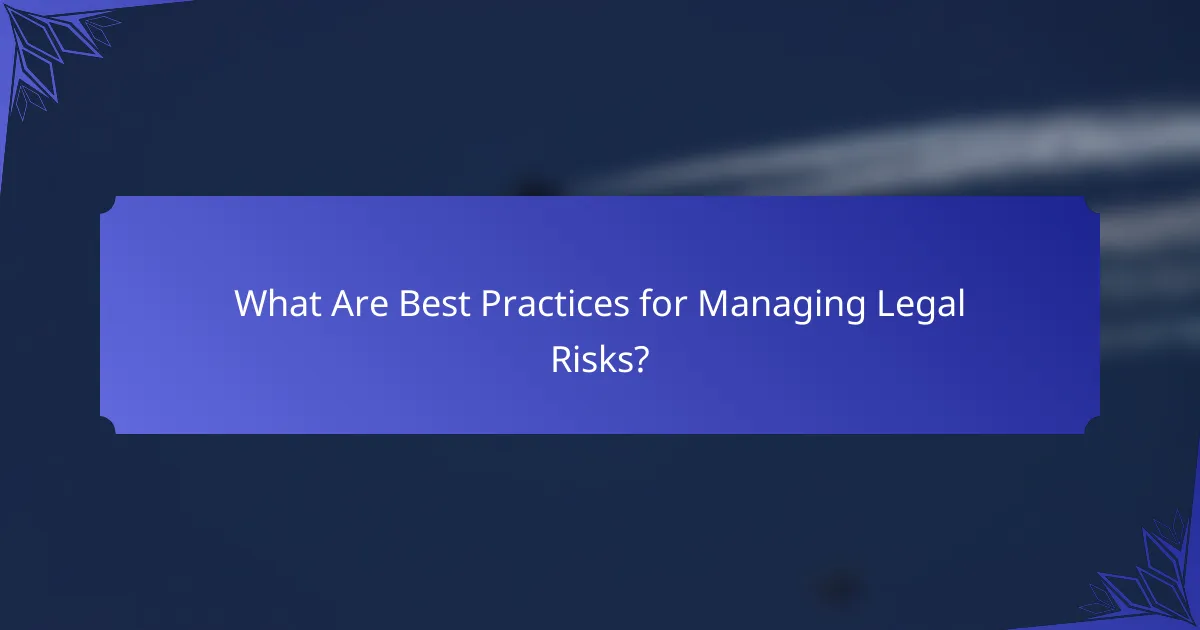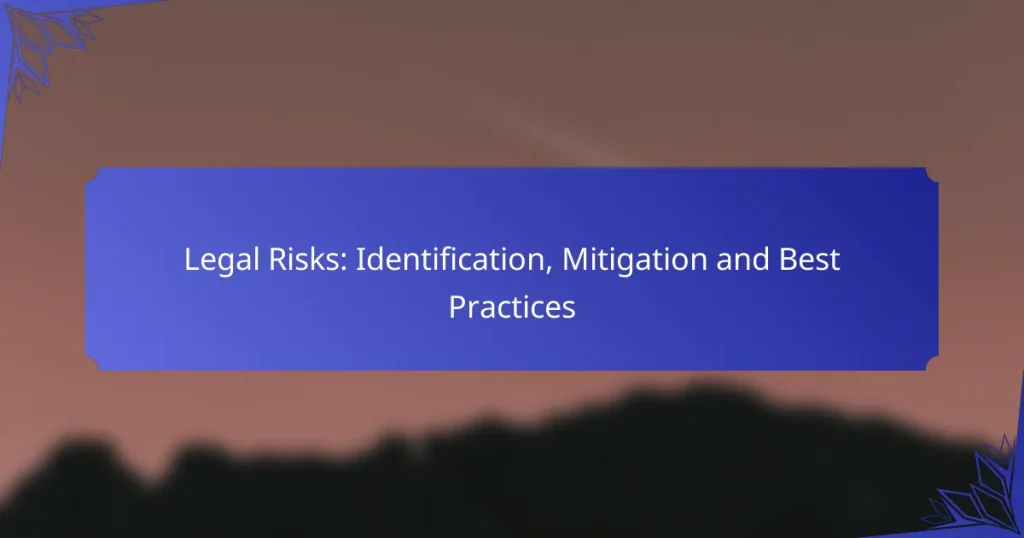Legal risks in business present significant challenges that can result in financial loss, reputational harm, or legal repercussions. Identifying these risks is essential for organizations to develop effective mitigation strategies, ensuring compliance with laws and regulations while maintaining operational stability.

What Are the Key Legal Risks in Business?
Key legal risks in business encompass various challenges that can lead to financial loss, reputational damage, or legal penalties. Identifying and managing these risks is crucial for maintaining compliance and ensuring operational stability.
Contractual risks
Contractual risks arise from the potential for disputes over agreements made with clients, suppliers, or partners. These risks can stem from unclear terms, unmet obligations, or failure to comply with contract provisions.
To mitigate contractual risks, businesses should ensure that contracts are clearly written, reviewed by legal professionals, and include well-defined terms and conditions. Regularly updating contracts to reflect changes in law or business circumstances is also essential.
Regulatory compliance risks
Regulatory compliance risks involve the possibility of failing to adhere to laws and regulations governing business operations. This can include industry-specific regulations, environmental laws, and financial reporting requirements.
To manage these risks, companies should stay informed about relevant regulations and implement compliance programs. Regular audits and employee training can help ensure adherence to legal standards and reduce the likelihood of penalties.
Intellectual property risks
Intellectual property risks pertain to the potential infringement of patents, trademarks, copyrights, or trade secrets. Businesses may face legal challenges if they inadvertently use protected materials or if their own intellectual property is infringed upon.
To protect intellectual property, companies should register their trademarks and patents, monitor for infringements, and enforce their rights when necessary. Educating employees about intellectual property rights can also help prevent unintentional violations.
Employment law risks
Employment law risks involve issues related to employee rights, workplace safety, and labor laws. These risks can lead to lawsuits or regulatory actions if employees are not treated fairly or if workplace conditions do not meet legal standards.
To mitigate employment law risks, businesses should establish clear employment policies, provide training on workplace rights, and conduct regular reviews of employment practices. Consulting with legal experts on labor laws can help ensure compliance.
Data privacy risks
Data privacy risks arise from the handling of personal information and the potential for data breaches. With increasing regulations like the GDPR in Europe and various state laws in the U.S., businesses must prioritize data protection.
To manage data privacy risks, companies should implement robust data security measures, conduct regular audits of data practices, and ensure compliance with applicable regulations. Training employees on data handling best practices is also critical to safeguarding sensitive information.

How to Identify Legal Risks?
Identifying legal risks involves recognizing potential legal issues that could affect an organization’s operations. This process is crucial for developing strategies to mitigate those risks and ensure compliance with applicable laws and regulations.
Risk assessment frameworks
Risk assessment frameworks provide structured approaches to identifying and analyzing legal risks. Common frameworks include the ISO 31000 and COSO ERM, which help organizations systematically evaluate risks based on likelihood and impact.
When using a risk assessment framework, consider factors such as industry-specific regulations and organizational policies. Regularly updating the assessment can help address emerging legal challenges.
Internal audits
Conducting internal audits is an effective way to identify legal risks within an organization. These audits review compliance with laws, regulations, and internal policies, often revealing areas of vulnerability.
Establish a routine for internal audits, such as quarterly or biannually, to ensure ongoing compliance. Engaging different departments can provide a comprehensive view of potential legal issues.
Consulting legal experts
Consulting legal experts is essential for accurately identifying legal risks. Lawyers or compliance officers can provide insights into specific legal obligations and potential liabilities relevant to your industry.
When seeking legal advice, ensure that the experts have experience in your sector. Regular consultations can help preemptively address legal challenges and keep your organization informed about changing laws.

What Are Effective Mitigation Strategies?
Effective mitigation strategies involve proactive measures to identify and reduce legal risks within an organization. These strategies can enhance compliance, protect against liabilities, and foster a culture of accountability.
Implementing compliance programs
Compliance programs are structured frameworks designed to ensure that an organization adheres to legal standards and regulations. These programs typically include policies, procedures, and monitoring systems tailored to the specific legal environment of the business.
To implement a successful compliance program, start by conducting a thorough risk assessment to identify potential legal vulnerabilities. Following this, develop clear policies and provide accessible resources to guide employees in adhering to legal requirements.
Regular training for employees
Regular training is essential for keeping employees informed about legal risks and compliance obligations. Training sessions should be interactive and tailored to the specific roles within the organization, ensuring relevance and engagement.
Consider scheduling training sessions at least annually, with additional refreshers or updates as needed. Incorporating real-world scenarios can help employees understand the practical implications of legal risks and the importance of compliance.
Utilizing legal technology tools
Legal technology tools can streamline compliance processes and enhance risk management. These tools range from document management systems to compliance tracking software, which can automate routine tasks and reduce human error.
When selecting legal technology solutions, consider factors such as ease of use, integration capabilities, and scalability. Investing in the right tools can significantly improve efficiency and ensure that your organization stays ahead of legal obligations.

What Are Best Practices for Managing Legal Risks?
Best practices for managing legal risks involve proactive strategies to identify, assess, and mitigate potential legal issues. These practices help organizations minimize exposure to lawsuits and regulatory penalties while ensuring compliance with applicable laws.
Establishing clear policies
Creating clear policies is essential for managing legal risks effectively. These policies should outline the organization’s legal obligations, compliance requirements, and procedures for handling legal matters. Regularly reviewing and updating these policies ensures they remain relevant and effective.
For example, a company might implement a code of conduct that addresses ethical behavior, conflict of interest, and compliance with industry regulations. Training employees on these policies can further reinforce their importance and reduce the likelihood of legal issues arising.
Engaging with legal counsel
Regular engagement with legal counsel is crucial for navigating complex legal landscapes. Legal experts can provide guidance on compliance, risk assessment, and contract negotiation, helping organizations avoid pitfalls. Establishing a relationship with a trusted attorney can facilitate timely advice and support when legal challenges arise.
Consider scheduling periodic consultations or retaining legal counsel on an ongoing basis to stay informed about changes in laws and regulations that may impact your business operations.
Documenting risk management processes
Thorough documentation of risk management processes is vital for demonstrating due diligence and compliance. This documentation should include risk assessments, mitigation strategies, and records of any legal consultations. Keeping detailed records can be invaluable in the event of a legal dispute or regulatory inquiry.
Utilizing a centralized system for tracking and managing legal risks can streamline documentation efforts. Regular audits of these processes can help identify areas for improvement and ensure that the organization is prepared for any legal challenges that may arise.

How to Choose the Right Legal Counsel?
Choosing the right legal counsel is crucial for effectively managing legal risks. Consider their expertise, local knowledge, and reputation to ensure they align with your specific needs.
Evaluating expertise in specific areas
When selecting legal counsel, assess their expertise in areas relevant to your situation, such as contract law, intellectual property, or compliance. Look for attorneys who have a proven track record in handling cases similar to yours.
Ask potential lawyers about their experience with specific regulations or industries. For instance, if you operate in the tech sector, seek counsel familiar with technology law and data protection regulations.
Considering local vs. national firms
Deciding between local and national firms depends on your needs. Local firms often have a better understanding of regional laws and can provide personalized service, while national firms may offer broader resources and expertise.
Consider the complexity of your legal issues. For straightforward matters, a local firm may suffice. However, for intricate cases requiring extensive resources, a national firm might be more suitable. Weigh the costs, as local firms may charge lower fees compared to their national counterparts.


